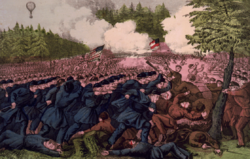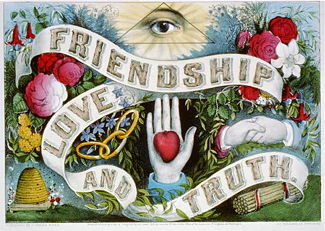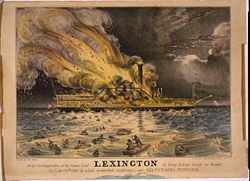Currier and Ives
Currier and Ives was an American printmaking firm headed by Nathaniel Currier (1813–1888) and James Merritt Ives (1824–1895) and based in New York City.
It was founded in New York in 1835 by Nathaniel T. Currier (1813-88), who had been apprenticed as a youth to the Boston lithographic firm of William S. & John Pendleton. Currier & Ives lithographs initially appeared under Currier's imprint (his earlier lithographs had been issued in 1834 under the name of Stodart & Currier), and the name Currier & Ives first appeared in 1857, when James Merritt Ives (1824-95), the company's bookkeeper and Currier's brother-in-law, was made a partner.
Currier and Ives greatly increased the public demand for graphic images by publishing fine-quality, black-and-white and hand-colored lithographs depicting disasters, political satire, views of city life, outdoor country scenes, and sentimental domestic scenes.
In the early 19th century newspapers lacked photographs; but the public was interested in some source of pictures of recent news stories. The success of Currier & Ives was part of the larger story of widespread American upward mobility and the mechanization of publishing.[1]
Early history
Lithography had begun in America in the 1820s. It was quicker and less expensive than engraving, hence the remarkable success of the firm of Currier and Ives. Soon after setting up business they produced extensive folios, usually based on paintings. Some of the work was crude, but the quality varied considerably. The star artists of the firm were Arthur F. Tait, who specialized in sporting scenes; Louis Maurer, who executed genre scenes; Fanny Palmer, who liked to do picturesque panoramas of the American landscape; and George H. Durrie, who supplied winter scenes. In 1835, Currier produced the print "Ruins of the Planter's Hotel, New Orleans, which fell at two O’clock on the Morning of the 15th of May 1835, burying 50 persons, 40 of whom Escaped with their Lives", which was moderately successful.
In 1840, he produced "Awful Conflagration of the Steam Boat LEXINGTON In Long Island Sound on Monday Eveg, Jany 13th, 1840, by which melancholy occurrence over 100 PERSONS PERISHED", which was very successful. Currier soon had a weekly insert in the New York Sun.
In 1852, Ives became the firm's accountant. Ives improved the firm's bookkeeping and streamlined print production. In 1857, he became a partner in the firm. He and Ives became close friends.
Currier and Ives described itself as "Publishers of Cheap and Popular Pictures". Their pictures were indeed hugely popular; in 1835–1907, Currier and Ives produced more than a million prints by hand-colored lithography. A staff of artists produced the lithographs. The colors were applied by an assembly line, typically German immigrant girls, each of whom added a single color to the print.
The prints depicted a variety of images of American life, including winter scenes; horse-racing images; portraits of people; and pictures of ships, sporting events, and ferocious battles of the American Civil War.
Currier died in 1888. Ives remained active in the firm until his death, in 1895. Because of improvements in offset printing and photoengraving, the public demand for lithographs gradually diminished. Currier and Ives closed in 1907.
Prolific production
So well known did Currier and Ives become that it was common to refer to any large mixed batch of prints as Currier and Ives prints. The firm was astoundingly prolific and produced prints on practically every aspect of the American scene. In the 1870s they issued four catalogs featuring 2800 subject titles.
Currier and Ives sometimes focused on current events. (In 1840 Currier produced what may have been the first illustrated "extra" in history when he depicted scenes of the fire that had broken out that year aboard the steamship Lexington in Long Island Sound.) Political cartoons and banners were commonly produced, like the Presidential Fishing Party of 1848, showing the candidates with fishing poles trying to hook fish on which names of various states are inscribed.

Historical prints were another field, and copies from the historical paintings of John Trumbull were especially popular. The Civil War print Battle of Fair Oaks, Va., May 31, 1862 shows the first balloon ever used for warfare observation. Sentimental prints included one showing a married couple walking along a riverbank and another showing a girl taking care of her little sister. There were also prints for children, such as Robinson Crusoe and His Pets and Noah's Ark; country and pioneer home scenes, which included Early Winter, a beautiful scene of people skating on a frozen pond before a snow-covered country cottage; and lithographed sheet music. Still other categories were Mississippi River prints, including On the Mississippi Loading Cotton and Midnight Race on the Mississippi; railroad prints that sometimes featured minute descriptions of trains, as in "Lightning Express" Trains Leaving the Junction; and home prints, which were produced in especially large quantities.
Currier and Ives avoided controversial subjects, although there was at least one print showing the branding of slaves prior to embarkation from Africa. Prints of sporting events focused on prize fights (like the 1835 match between John C. Heeman and the English champion Tom Sayers), boat races, and even, in the early stages of its development, baseball.
As America expanded, so did the demand for Currier and Ives prints. Today they provide a vivid picture of daily life in 19th-century America.
After Nathaniel Currier retired in 1880 his son Edward ran the firm with Ives. By 1907 both families were out of the business, which folded shortly thereafter. Although the lithographs never lost their appeal, and indeed gained in value after the firm closed, improvements in photography doomed lithography as the chief means of illustrating everyday life.
Gallery
- Dartmouth College - Dartmouth Hall circa 1834.jpg
Dartmouth College -Dartmouth Hall (1834).
Freedom to Ireland (1866).
Marriage certificate (1869).
Delicious Coffee (1881).
Woman's Holy War (Temperance) (1874).
The Freedmen's Bureau (1868).
God spake all these words (10 commandments) (1876).
Abraham Lincoln: The martyred president (1865).
Andrew Jackson, brave boy (1876).
Legacy
Today, original Currier and Ives prints are much sought by collectors, and modern reproductions of them are popular decorations. Especially popular are the winter scenes, which are commonly used on American Christmas cards.
Mitchell Parish's lyrics to Leroy Anderson's orchestra piece "Sleigh Ride" mention the company by name, stating that a merry indoor scene at a farm during the winter will "nearly be like a picture print by Currier and Ives".
Notes
- ↑ Currier & Ives, Printmakers to the American People Tfaoi.com. Retrieved November 19, 2007.
ReferencesISBN links support NWE through referral fees
- Peters, Harry Twyford. 1942. Currier & Ives, printmakers to the American people. Garden City, N.Y.: Doubleday, Doran. OCLC 14221758
- LeBeau, Bryan F. 2001. Currier and Ives America Imagined. Washington, D.C.: Smithsonian Institution Press. ISBN 1560989904
- Crouse, Russel. 1930. Mr. Currier and Mr. Ives a note on their lives and times. Garden City, N.Y.: Doubleday, Doran. OCLC 1099005
- O'Rourke, Kevin. 1995. Currier and Ives: the Irish and America. New York: H.N. Abrams. ISBN 0810940361
- Currier & Ives, and Albert K. Baragwanath. 1979. Currier and Ives Favorites. New York: Crown Publishers. ISBN 0517535475
- Bonfante-Warren, Alexandra. 1998. Currier & Ives: portraits of a nation. New York: MetroBooks. ISBN 1567995896
External links
- Online Gallery of Currier & Ives Prints
- Currier & Ives—Complete History, References, Restorations and Gallery
- Currier & Ives, Printmakers to the American People
- History in Context: Currier & Ives "Darktown Comics" Albion.edu. Retrieved November 30, 2007.
- Commercial restoration site with additional information
Credits
New World Encyclopedia writers and editors rewrote and completed the Wikipedia article in accordance with New World Encyclopedia standards. This article abides by terms of the Creative Commons CC-by-sa 3.0 License (CC-by-sa), which may be used and disseminated with proper attribution. Credit is due under the terms of this license that can reference both the New World Encyclopedia contributors and the selfless volunteer contributors of the Wikimedia Foundation. To cite this article click here for a list of acceptable citing formats.The history of earlier contributions by wikipedians is accessible to researchers here:
The history of this article since it was imported to New World Encyclopedia:
Note: Some restrictions may apply to use of individual images which are separately licensed.

















